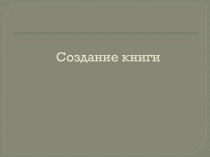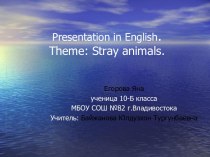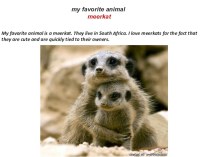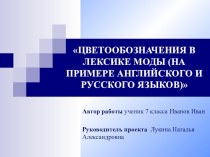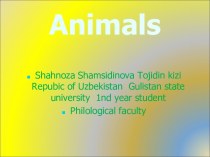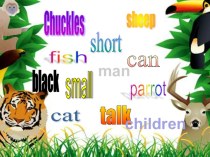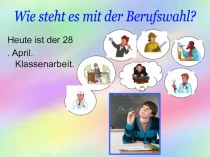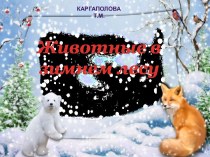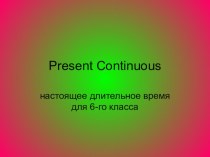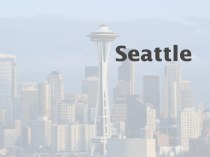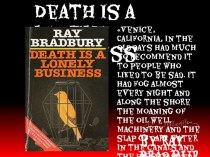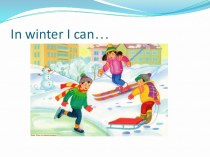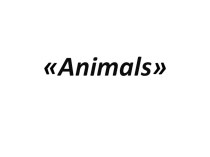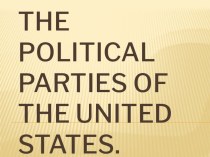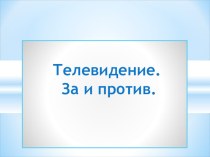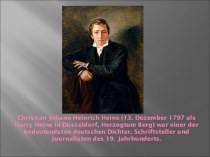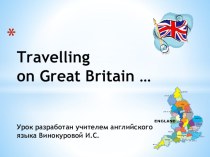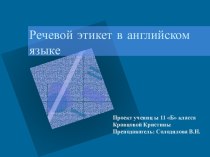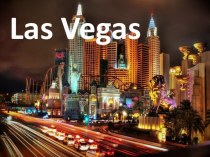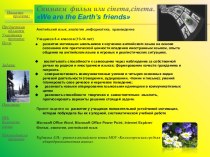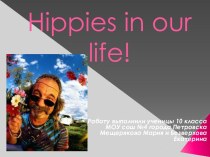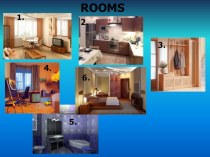- Главная
- Разное
- Бизнес и предпринимательство
- Образование
- Развлечения
- Государство
- Спорт
- Графика
- Культурология
- Еда и кулинария
- Лингвистика
- Религиоведение
- Черчение
- Физкультура
- ИЗО
- Психология
- Социология
- Английский язык
- Астрономия
- Алгебра
- Биология
- География
- Геометрия
- Детские презентации
- Информатика
- История
- Литература
- Маркетинг
- Математика
- Медицина
- Менеджмент
- Музыка
- МХК
- Немецкий язык
- ОБЖ
- Обществознание
- Окружающий мир
- Педагогика
- Русский язык
- Технология
- Физика
- Философия
- Химия
- Шаблоны, картинки для презентаций
- Экология
- Экономика
- Юриспруденция
Что такое findslide.org?
FindSlide.org - это сайт презентаций, докладов, шаблонов в формате PowerPoint.
Обратная связь
Email: Нажмите что бы посмотреть
Презентация на тему Principles of European construction
Содержание
- 2. Construction européenne - Licence 2, ФИНЭК/Grenoble III
- 3. Construction européenne - Licence 2, ФИНЭК/Grenoble IIPlaying
- 4. Construction européenne - Licence 2, ФИНЭК/Grenoble IIFor begin...Union European = Europe ?
- 5. Construction européenne - Licence 2, ФИНЭК/Grenoble II
- 6. Construction européenne - Licence 2, ФИНЭК/Grenoble IISome
- 7. Construction européenne - Licence 2, ФИНЭК/Grenoble IIGeography of the EU
- 8. Construction européenne - Licence 2, ФИНЭК/Grenoble IISome
- 9. Construction européenne - Licence 2, ФИНЭК/Grenoble IISome
- 10. Construction européenne - Licence 2, ФИНЭК/Grenoble II
- 11. Construction européenne - Licence 2, ФИНЭК/Grenoble IIEnlargments1957
- 12. Construction européenne - Licence 2, ФИНЭК/Grenoble IIGeography of the EU
- 13. Construction européenne - Licence 2, ФИНЭК/Grenoble IIOther
- 14. Construction européenne - Licence 2, ФИНЭК/Grenoble IIEU
- 15. Construction européenne - Licence 2, ФИНЭК/Grenoble IIWhat
- 16. Construction européenne - Licence 2, ФИНЭК/Grenoble IINatural
- 17. Construction européenne - Licence 2, ФИНЭК/Grenoble IIGeographical
- 18. Construction européenne - Licence 2, ФИНЭК/Grenoble IIPolitical
- 19. Construction européenne - Licence 2, ФИНЭК/Grenoble IILegislative
- 20. Construction européenne - Licence 2, ФИНЭК/Grenoble IIEconomical
- 21. Construction européenne - Licence 2, ФИНЭК/Grenoble IICultural
- 22. Construction européenne - Licence 2, ФИНЭК/Grenoble IILimitsDespite
- 23. Construction européenne - Licence 2, ФИНЭК/Grenoble IIII
- 24. Construction européenne - Licence 2, ФИНЭК/Grenoble IIStages
- 25. Construction européenne - Licence 2, ФИНЭК/Grenoble IIDifferent types Minilateralism Multilateralism Strategies of integration
- 26. Construction européenne - Licence 2, ФИНЭК/Grenoble IIGlobalisation
- 27. Construction européenne - Licence 2, ФИНЭК/Grenoble IIExamples
- 28. Construction européenne - Licence 2, ФИНЭК/Grenoble IIQuestions?Thank
- 29. Construction européenne - Licence 2, ФИНЭК/Grenoble IIStudents’
- 30. Скачать презентацию
- 31. Похожие презентации
Construction européenne - Licence 2, ФИНЭК/Grenoble III – Review of the EUWhat is the EU ?EU in the world
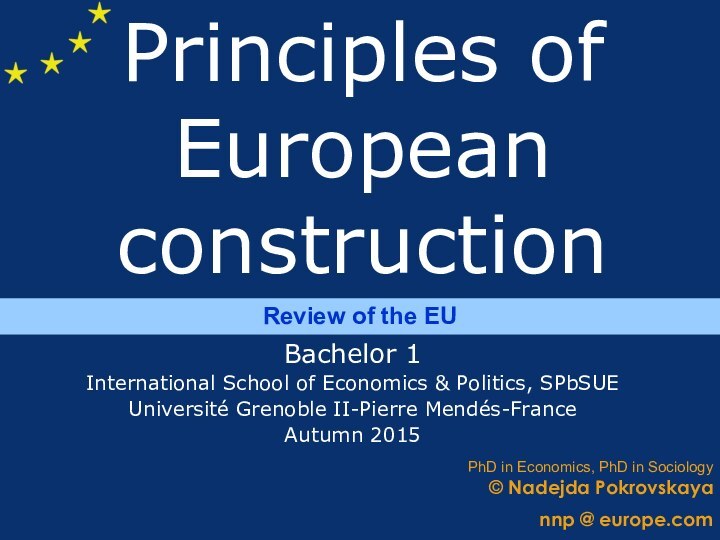

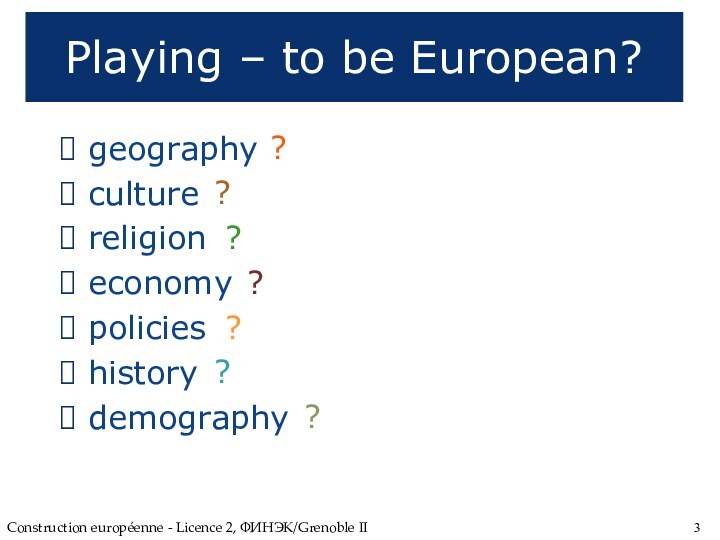
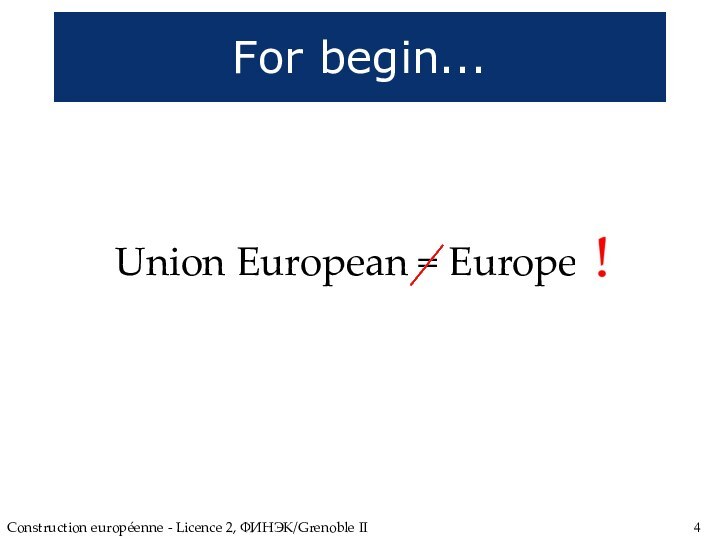

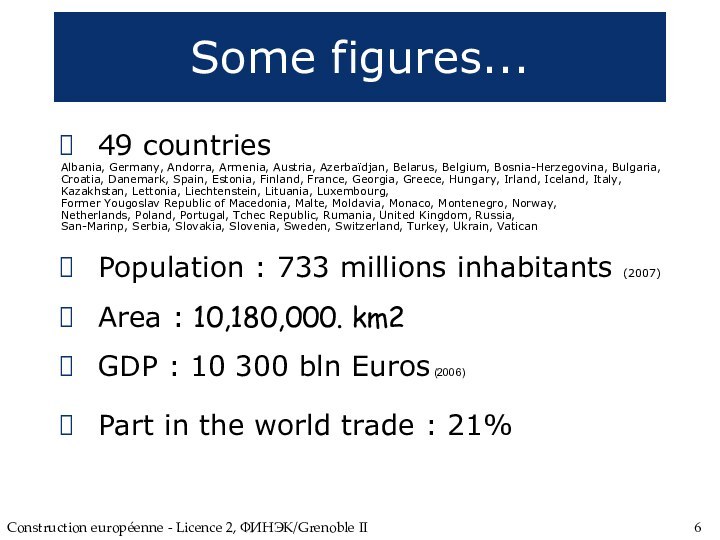
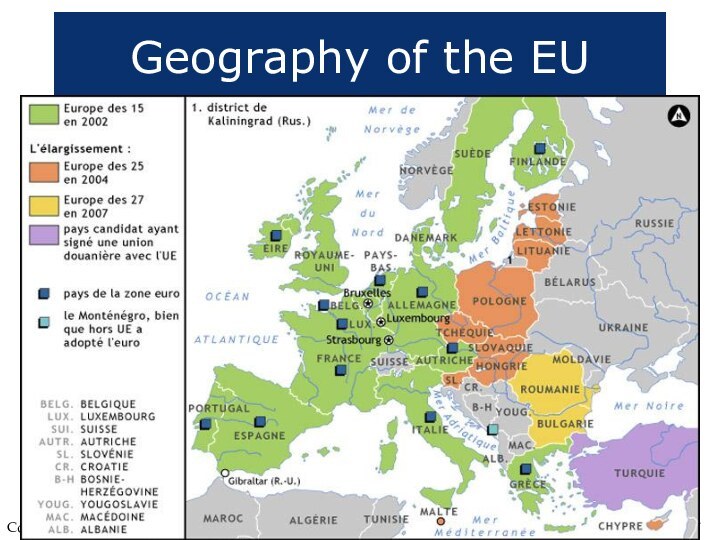
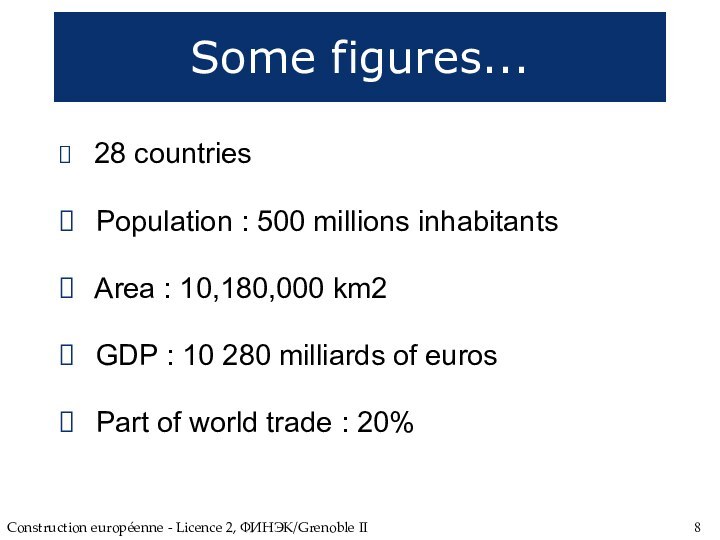
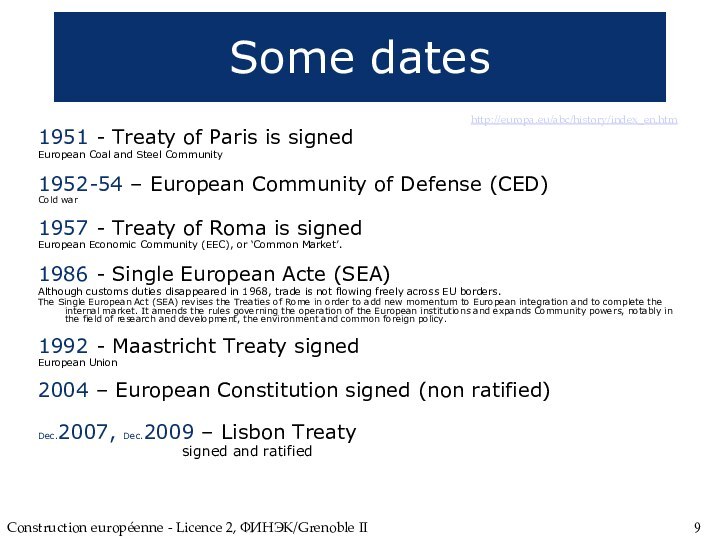
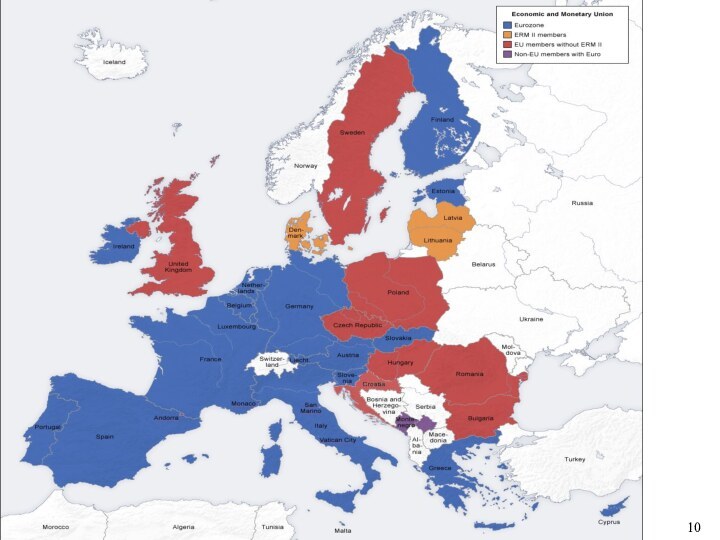
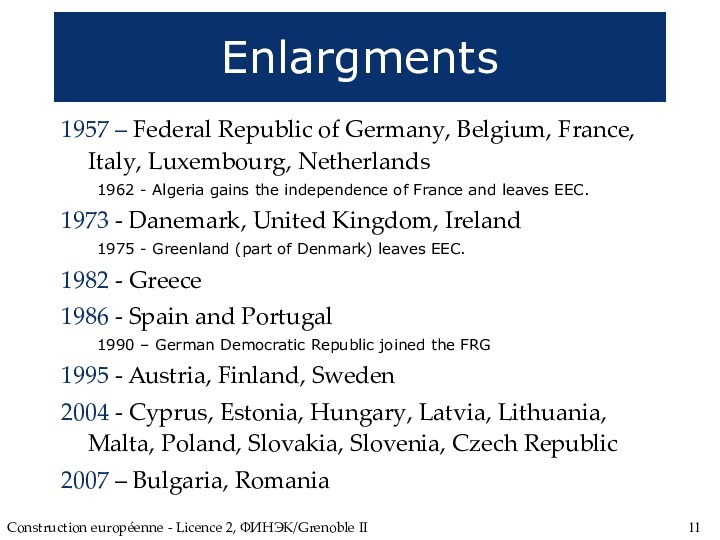
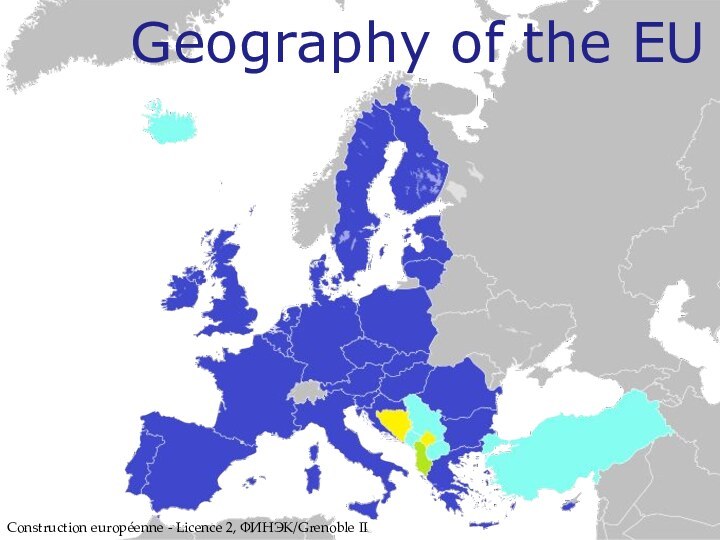
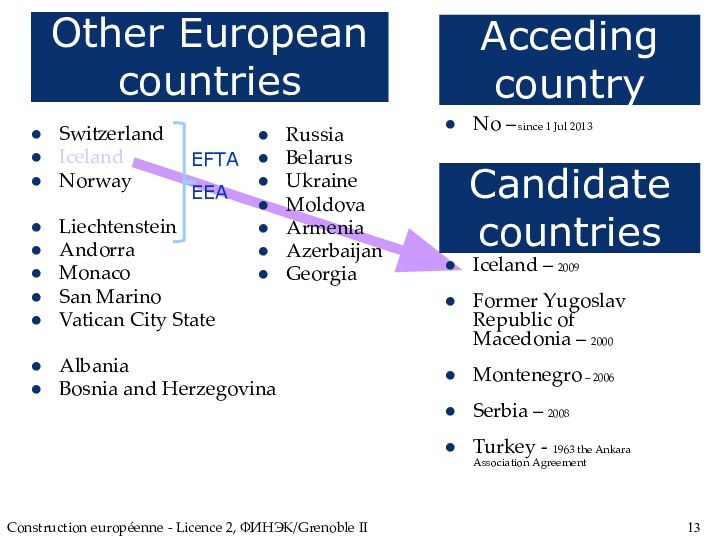

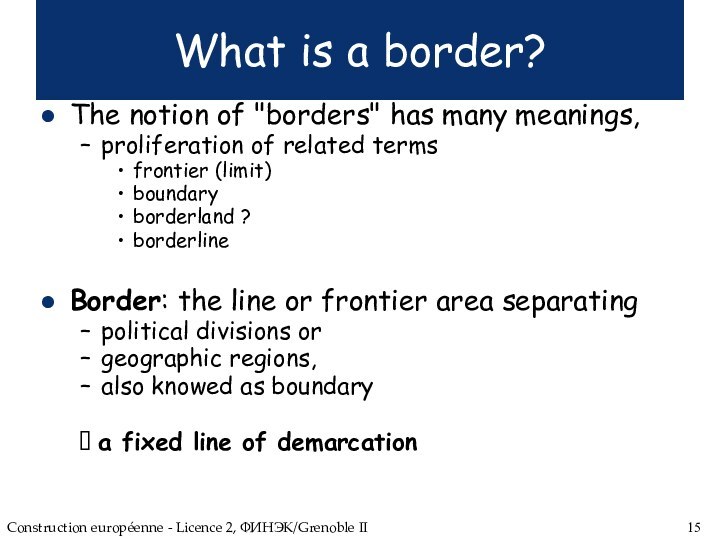
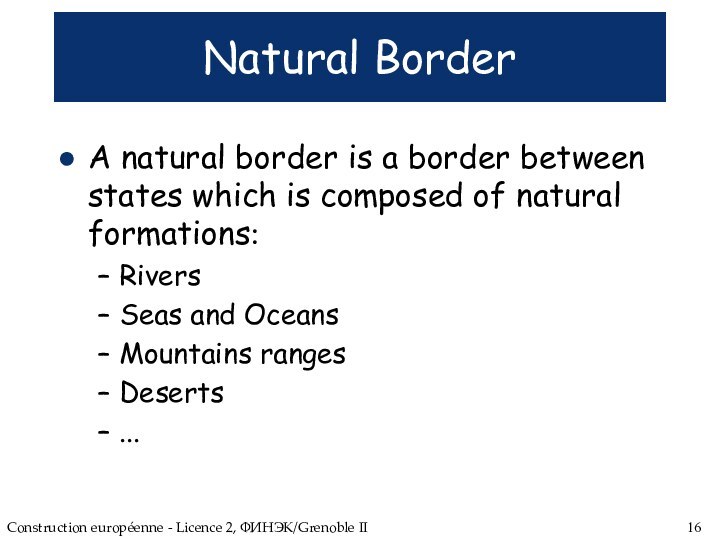
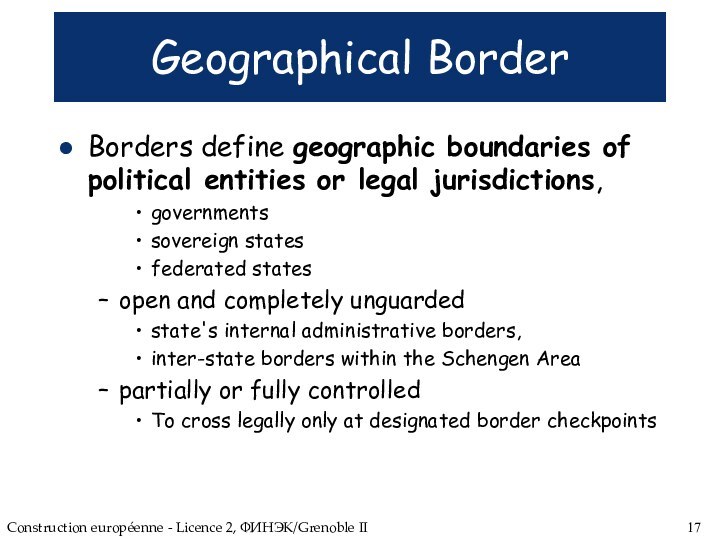
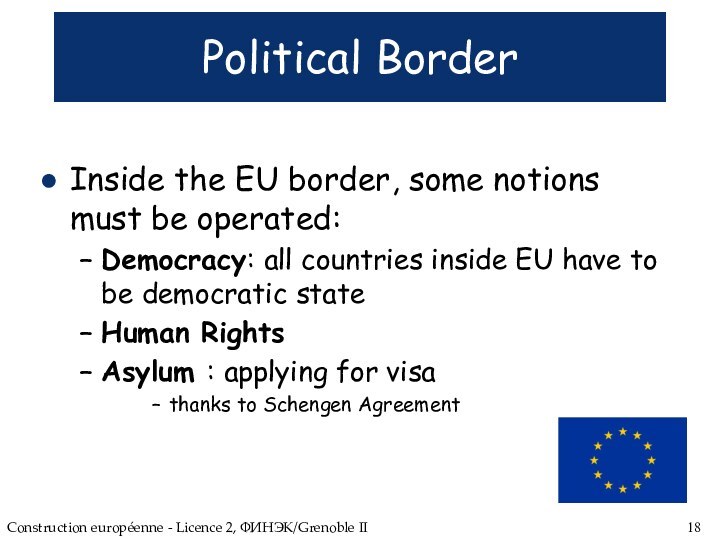
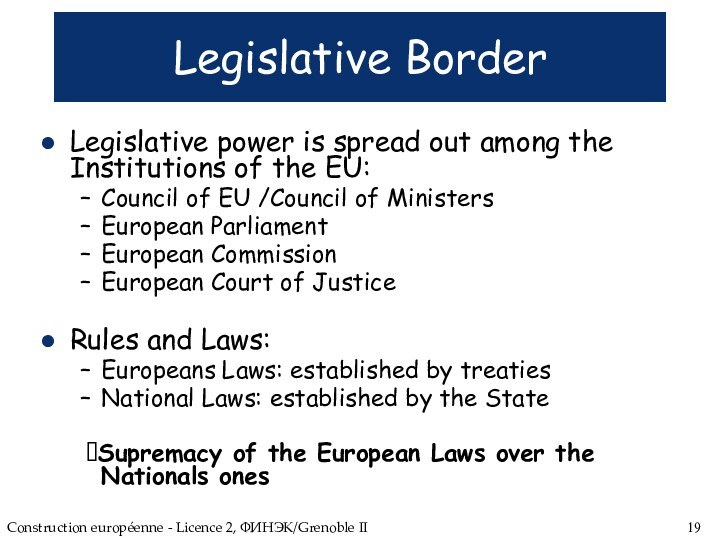
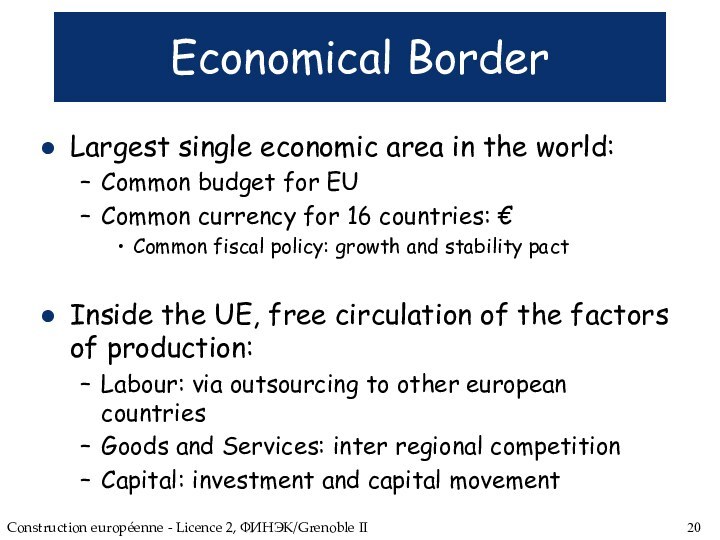
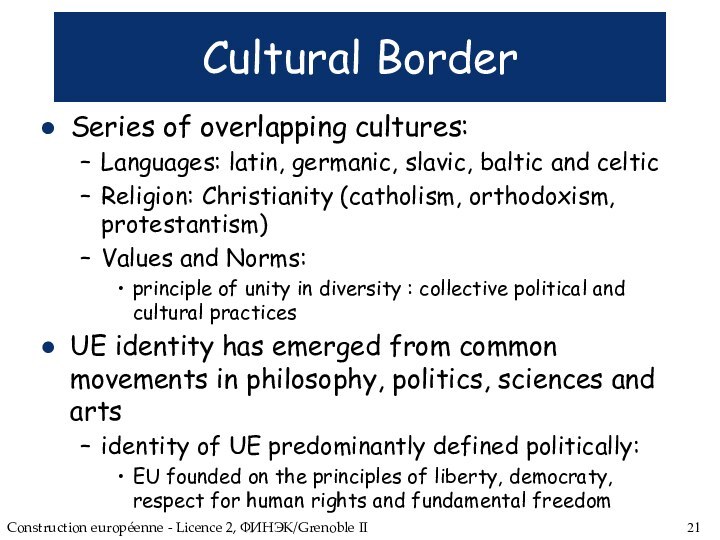
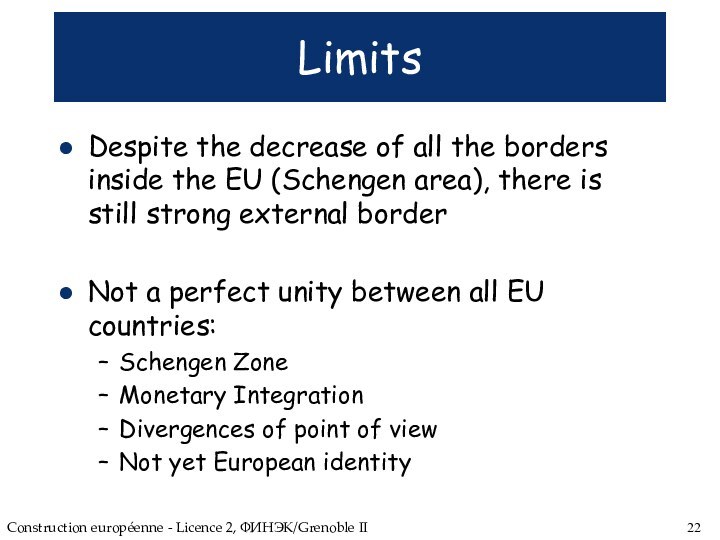
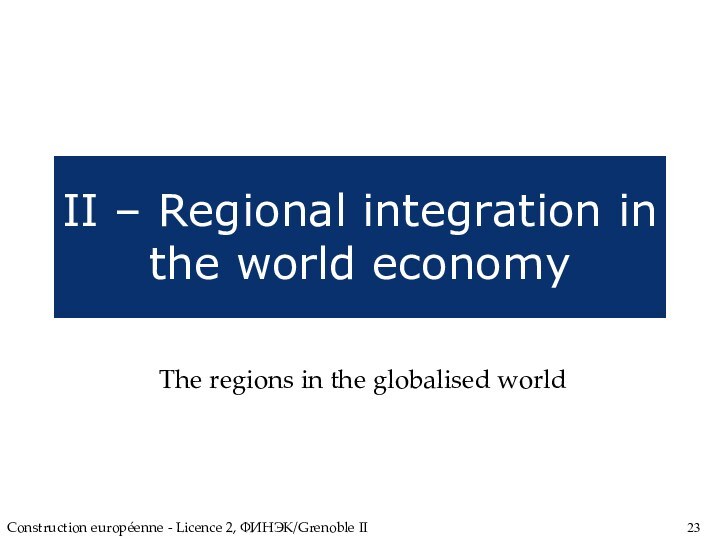

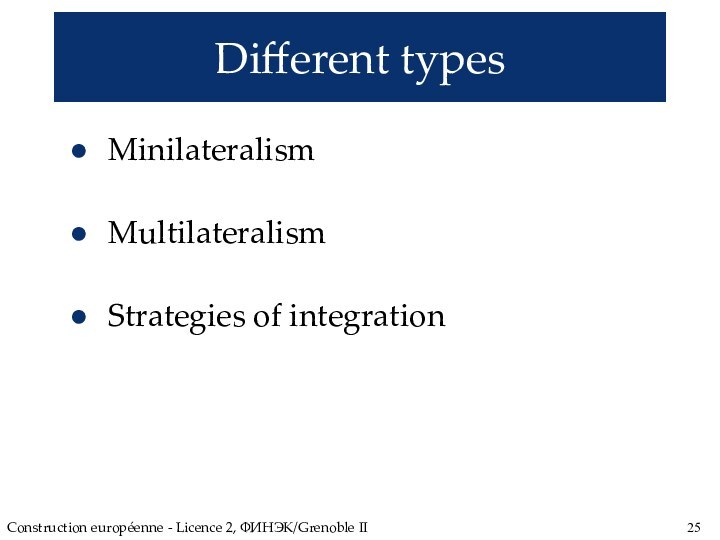
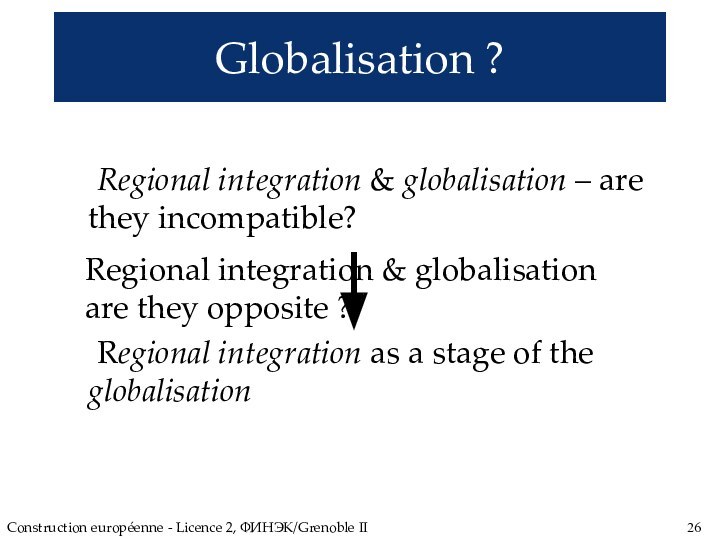
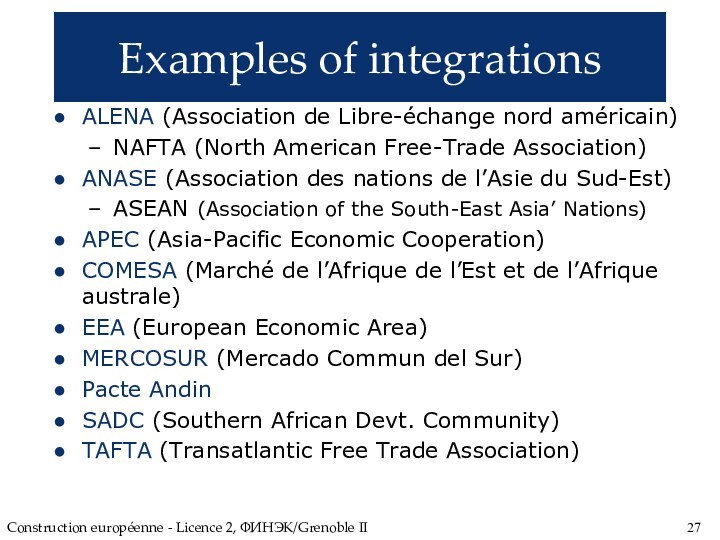
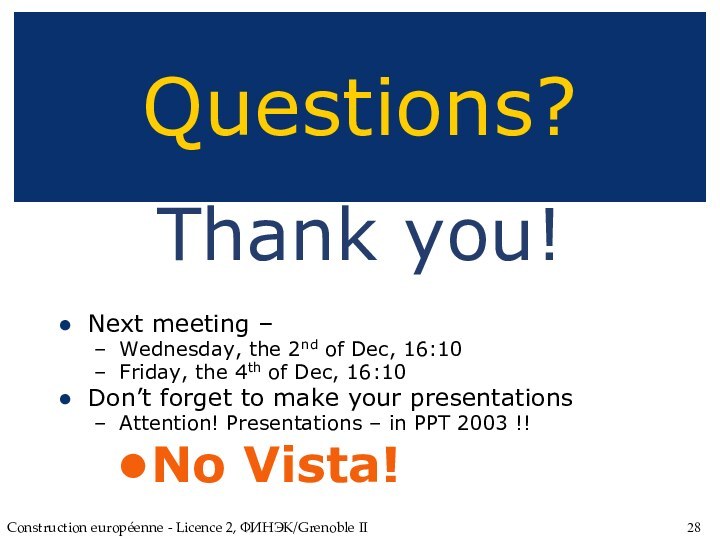
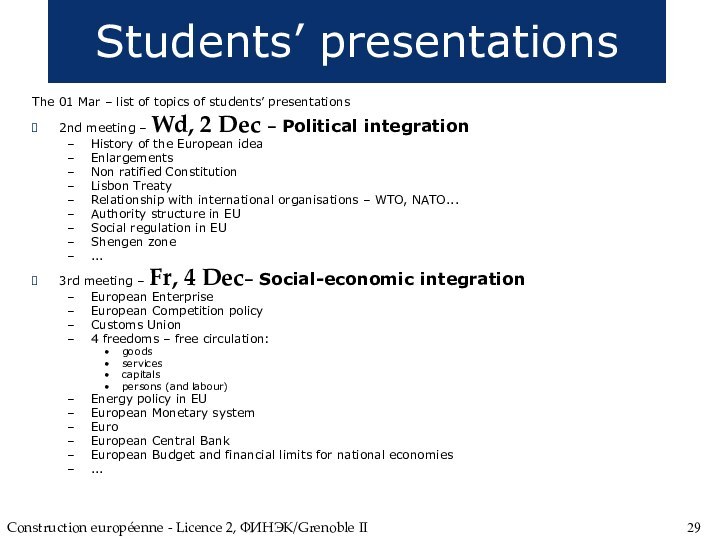
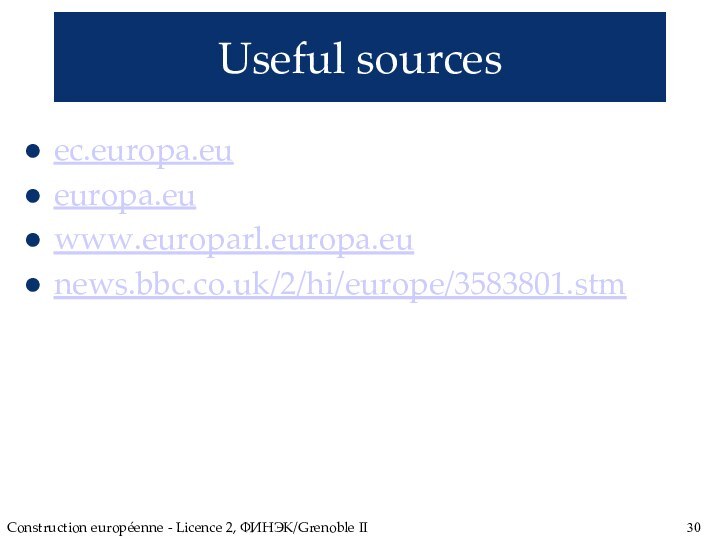
Слайд 3
Construction européenne - Licence 2, ФИНЭК/Grenoble II
Playing –
to be European?
geography
culture
religion
economy
policies
history
demography
?
?
?
??
?
?
Слайд 6
Construction européenne - Licence 2, ФИНЭК/Grenoble II
Some figures...
49 countries
Albania, Germany, Andorra, Armenia, Austria, Azerbaïdjan, Belarus, Belgium,
Bosnia-Herzegovina, Bulgaria,Croatia, Danemark, Spain, Estonia, Finland, France, Georgia, Greece, Hungary, Irland, Iceland, Italy,
Kazakhstan, Lettonia, Liechtenstein, Lituania, Luxembourg,
Former Yougoslav Republic of Macedonia, Malte, Moldavia, Monaco, Montenegro, Norway,
Netherlands, Poland, Portugal, Tchec Republic, Rumania, United Kingdom, Russia,
San-Marinp, Serbia, Slovakia, Slovenia, Sweden, Switzerland, Turkey, Ukrain, Vatican
Population : 733 millions inhabitants (2007)
Area : 10,180,000. km2
GDP : 10 300 bln Euros (2006)
Part in the world trade : 21%
Слайд 8
Construction européenne - Licence 2, ФИНЭК/Grenoble II
Some figures...
28 countries
Population : 500 millions inhabitants
Area :
10,180,000 km2GDP : 10 280 milliards of euros
Part of world trade : 20%
Слайд 9
Construction européenne - Licence 2, ФИНЭК/Grenoble II
Some dates
http://europa.eu/abc/history/index_en.htm
1951
- Treaty of Paris is signed
European Coal and Steel
Community 1952-54 – European Community of Defense (CED)
Cold war
1957 - Treaty of Roma is signed
European Economic Community (EEC), or ‘Common Market’.
1986 - Single European Acte (SEA)
Although customs duties disappeared in 1968, trade is not flowing freely across EU borders.
The Single European Act (SEA) revises the Treaties of Rome in order to add new momentum to European integration and to complete the internal market. It amends the rules governing the operation of the European institutions and expands Community powers, notably in the field of research and development, the environment and common foreign policy.
1992 - Maastricht Treaty signed
European Union
2004 – European Constitution signed (non ratified)
Dec.2007, Dec.2009 – Lisbon Treaty
signed and ratified
Слайд 11
Construction européenne - Licence 2, ФИНЭК/Grenoble II
Enlargments
1957 –
Federal Republic of Germany, Belgium, France, Italy, Luxembourg, Netherlands
1962
- Algeria gains the independence of France and leaves EEC.1973 - Danemark, United Kingdom, Ireland
1975 - Greenland (part of Denmark) leaves EEC.
1982 - Greece
1986 - Spain and Portugal
1990 – German Democratic Republic joined the FRG
1995 - Austria, Finland, Sweden
2004 - Cyprus, Estonia, Hungary, Latvia, Lithuania, Malta, Poland, Slovakia, Slovenia, Czech Republic
2007 – Bulgaria, Romania
Слайд 13
Construction européenne - Licence 2, ФИНЭК/Grenoble II
Other European
countries
Switzerland
Iceland
Norway
Liechtenstein
Andorra
Monaco
San Marino
Vatican
City StateAlbania
Bosnia and Herzegovina
Acceding country
No – since 1 Jul 2013
Iceland – 2009
Former Yugoslav Republic of
Macedonia – 2000
Montenegro – 2006
Serbia – 2008
Turkey - 1963 the Ankara Association Agreement
Russia
Belarus
Ukraine
Moldova
Armenia
Azerbaijan
Georgia
Candidate countries
EFTA
EEA
Слайд 14
Construction européenne - Licence 2, ФИНЭК/Grenoble II
EU Future
Enlargements
Turkey ?
CIS / Russia ?
Maghreb? (Northern Africa)
Israël ?
Middle East?
Слайд 15
Construction européenne - Licence 2, ФИНЭК/Grenoble II
What is
a border?
The notion of "borders" has many meanings,
proliferation
of related terms frontier (limit)
boundary
borderland ?
borderline
Border: the line or frontier area separating
political divisions or
geographic regions,
also knowed as boundary
? a fixed line of demarcation
Слайд 16
Construction européenne - Licence 2, ФИНЭК/Grenoble II
Natural Border
A
natural border is a border between states which is
composed of natural formations:Rivers
Seas and Oceans
Mountains ranges
Deserts
...
Слайд 17
Construction européenne - Licence 2, ФИНЭК/Grenoble II
Geographical Border
Borders
define geographic boundaries of political entities or legal jurisdictions,
governments
sovereign states
federated states
open and completely unguarded
state's internal administrative borders,
inter-state borders within the Schengen Area
partially or fully controlled
To cross legally only at designated border checkpoints
Слайд 18
Construction européenne - Licence 2, ФИНЭК/Grenoble II
Political Border
Inside
the EU border, some notions must be operated:
Democracy: all
countries inside EU have to be democratic stateHuman Rights
Asylum : applying for visa
thanks to Schengen Agreement
Слайд 19
Construction européenne - Licence 2, ФИНЭК/Grenoble II
Legislative Border
Legislative
power is spread out among the Institutions of the
EU:Council of EU /Council of Ministers
European Parliament
European Commission
European Court of Justice
Rules and Laws:
Europeans Laws: established by treaties
National Laws: established by the State
?Supremacy of the European Laws over the Nationals ones
Слайд 20
Construction européenne - Licence 2, ФИНЭК/Grenoble II
Economical Border
Largest
single economic area in the world:
Common budget for EU
Common
currency for 16 countries: €Common fiscal policy: growth and stability pact
Inside the UE, free circulation of the factors of production:
Labour: via outsourcing to other european countries
Goods and Services: inter regional competition
Capital: investment and capital movement
Слайд 21
Construction européenne - Licence 2, ФИНЭК/Grenoble II
Cultural Border
Series
of overlapping cultures:
Languages: latin, germanic, slavic, baltic and celtic
Religion:
Christianity (catholism, orthodoxism, protestantism)Values and Norms:
principle of unity in diversity : collective political and cultural practices
UE identity has emerged from common movements in philosophy, politics, sciences and arts
identity of UE predominantly defined politically:
EU founded on the principles of liberty, democraty, respect for human rights and fundamental freedom
Слайд 22
Construction européenne - Licence 2, ФИНЭК/Grenoble II
Limits
Despite the
decrease of all the borders inside the EU (Schengen
area), there is still strong external borderNot a perfect unity between all EU countries:
Schengen Zone
Monetary Integration
Divergences of point of view
Not yet European identity
Слайд 23
Construction européenne - Licence 2, ФИНЭК/Grenoble II
II –
Regional integration in the world economy
The regions in the
globalised world
Слайд 24
Construction européenne - Licence 2, ФИНЭК/Grenoble II
Stages of
the international economic integration
Preferential Trade Area
a trading bloc which
gives preferential access to certain products from certain countries. This is done by reducing tariffs, but does not abolish them completely.Free-trade area (zone)
countries have agreed to eliminate tariffs, quotas and preferences on most (if not all) goods between them
Customs union
+ trade agreement by which a group of countries charges a common set of tariffs to the rest of the world while granting free trade among themselves.
Common market
+ common policies on product regulation, and freedom of movement of all the three factors of production (land, capital and labour) and of enterprise. The goal is that movement of capital, labour, goods and services between the members is as easy as within them
Economic and monetary Union
+ a common currency, economic and moneraty policies
Слайд 25
Construction européenne - Licence 2, ФИНЭК/Grenoble II
Different types
Minilateralism
Multilateralism
Strategies of integration
Слайд 26
Construction européenne - Licence 2, ФИНЭК/Grenoble II
Globalisation ?
Regional
integration & globalisation – are they incompatible?
Regional integration
as a stage of the globalisationRegional integration & globalisation are they opposite ?
Слайд 27
Construction européenne - Licence 2, ФИНЭК/Grenoble II
Examples of
integrations
ALENA (Association de Libre-échange nord américain)
NAFTA (North American Free-Trade
Association)ANASE (Association des nations de l’Asie du Sud-Est)
ASEAN (Association of the South-East Asia’ Nations)
APEC (Asia-Pacific Economic Cooperation)
COMESA (Marché de l’Afrique de l’Est et de l’Afrique australe)
EEA (European Economic Area)
MERCOSUR (Mercado Commun del Sur)
Pacte Andin
SADC (Southern African Devt. Community)
TAFTA (Transatlantic Free Trade Association)
Слайд 28
Construction européenne - Licence 2, ФИНЭК/Grenoble II
Questions?
Thank you!
Next
meeting –
Wednesday, the 2nd of Dec, 16:10
Friday, the
4th of Dec, 16:10Don’t forget to make your presentations
Attention! Presentations – in PPT 2003 !!
No Vista!
Слайд 29
Construction européenne - Licence 2, ФИНЭК/Grenoble II
Students’ presentations
The
01 Mar – list of topics of students’ presentations
2nd
meeting – Wd, 2 Dec – Political integrationHistory of the European idea
Enlargements
Non ratified Constitution
Lisbon Treaty
Relationship with international organisations – WTO, NATO...
Authority structure in EU
Social regulation in EU
Shengen zone
...
3rd meeting – Fr, 4 Dec– Social-economic integration
European Enterprise
European Competition policy
Customs Union
4 freedoms – free circulation:
goods
services
capitals
persons (and labour)
Energy policy in EU
European Monetary system
Euro
European Central Bank
European Budget and financial limits for national economies
...
